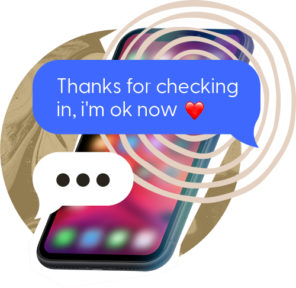One Conversation Can Change a Life
Now more than ever, it’s important to show the people in our lives that we’re here to support them if they need help.


Suicide is the 2nd-leading cause of death for high school-aged youth.

Warning Signs
Here are some things to watch for:
- Talking about suicide or a sudden interest in death
- Reported feelings of hopelessness, worthlessness, or deep depression
- Risk-seeking or destructive behavior
- Acting out of character
- Loss of interest in valued activities
- Reaching out to important people in one’s life
- Giving away prized possessions
- Previous suicide attempts

Treatment & Recovery
Managing recovery:
- Spend time doing things you love
- Have a support network in place
- In some cases, medical treatment may be appropriate
Supporting recovery:
- Resist the myths and stigmas that make recovery more challenging
- Be prepared to listen
- Make future plans with a person who is struggling
Knowing the risk factors for suicidal ideation can also help you recognize when someone needs help.

4 out of 5 teens who attempt suicide have given clear warning signs.
Helpful Resources

How to Talk With Your Child About Suicide
It’s important to show your kid that they can come to you if they’re struggling. This blog post can help you start the conversation.

Top 10 Resources for Suicide Prevention
You can find hotlines, text lines, statistics, and more to support your family and loved ones with these organizations and resources.

Supporting Your Child During
COVID-19
The COVID-19 pandemic presents young people with unique challenges. Find out what you need to know and how to support your kid.

A Resource Guide for Families
This guide contains warning signs, expert advice, and resources for helping parents and kids handle the complex issue of suicide.
In this video, Bark chief parent officer Titania Jordan sits down with Chris Taylor, a marriage and family therapist, to talk about suicidal ideation, mental health, and digital technology.

48% of LGBTQ kids ages 13–17 have seriously considered suicide in the last year.
Additional Resources

The age-adjusted suicide rate increased by 35% between 1999–2018.

How Bark Can Help
At Bark, we know first-hand just how urgent it is to offer support and guidance to help prevent suicide. The issue can seem difficult to grasp, but every statistic represents real people who need help. In 2021:
- Bark saw a 25.15% increase in alerts for self-harm and suicidal ideation among kids ages 12–18, as compared with 2020.
- 43.09% of tweens and 74.61% of teens were involved in a self-harm/suicidal situation.
- 32.11% of tweens and 56.40% of teens engaged in conversations about depression.
The Tools to Reach Out
“Thank you! I can’t explain how grateful I am to Bark for the self-harm/suicide notification. My son googled the suicide prevention hotline number to give to a friend that was struggling. Because of Bark, it opened up a line of communication with him. We were able to talk through it and I could provide him with the tools to reach out and help his friend.”
— Bark Parent


Try Bark for Free for 7 Days
Bark monitors online activities and alerts parents and guardians to potential issues, including suicidal ideation, depression, self-harm, and more.
